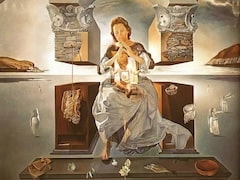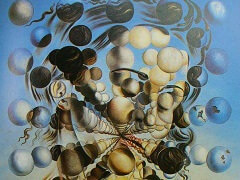Still Life - Fast Moving, 1956 by Salvador Dali

By the time Dali painted this work, he had left Surrealism behind and was fully immersed in what he called "Nuclear Mysticism." Dali felt that the art of his contemporaries was spiritually barren, and he was determined to reanimate art with spirituality. He was convinced that the emerging theories of physics and molecular biology could reveal the mysteries of religion.
In the first years of the atomic era following World War II, Dali was fully absorbed by scientific discovery and mathematical theory. This painting incorporates math and science in two ways. First, it illustrates that our world of solid objects is made of subatomic particles in constant motion. To visualize this, Dali chose to reinterpret a traditional still-life painting much as he did in Basket of Bread thirty years earlier. Familiar still-life objects - a table, fruits and vegetables, a glass, a dish, and cutlery - circle each other in suspended animation. Though elements in the composition are in motion, there is a sense of suspended time. This is further reinforced by the title, "Nature Morte Vivante," a still life in motion.
This painting also depicts the importance of the spiral, which Dali believed was nature's most perfect form, using it as a symbol of cosmic order. Spiral structures can be found throughout this work, from the rhinoceros horn in the upper left, to the twisting fruit dish in the center, to the meteor-like head of cauliflower on the right. While working on this painting, Dali was thrilled to hear of the discovery that the DNA molecule - the blueprint for all life - had a spiral shape. The double spiral balcony railing to the left is Dali's acknowledgment of DNA. Dali said:
For the first time in the history of science, physics was providing proof of the existence of God."























